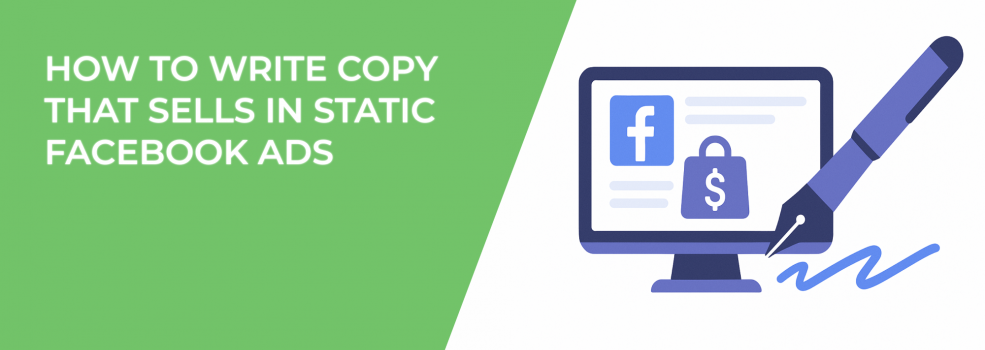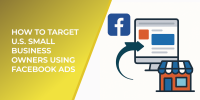Static Facebook ads may look simple, but simplicity is deceptive. One image. A few lines of text. A button. That’s all you get — which is exactly why the words you choose matter so much.
When your copy works, it pulls people out of the scroll and gets them to click. When it doesn’t, your ad just becomes another piece of background noise. So, how do you write text that actually sells? Let’s dive in.
1. Lead With Benefits, Not Features
People scrolling Facebook aren’t looking for a technical breakdown. They want to know what’s in it for them.
Swap “Advanced skincare formula with hyaluronic acid” for “Smooth, glowing skin in just two weeks”. One talks about an ingredient, the other highlights the result. Which one do you think makes people stop?
Tip: Write down three pain points your audience struggles with. Then, craft headlines that directly address each one. This way, your ad copy feels like a direct answer to their problem.
When you know your audience’s pain points, you can write copy that feels like a solution, not just a product description. For a deeper look at how targeting shapes messaging, check out Facebook Ads Targeting Updates: How To Adapt in 2025.
2. Write Headlines That Snap Attention
Static ads don’t move. Your words have to.
Keep your headline short, punchy, and outcome-driven. Something like:
-
“Get More Clients This Month”
-
“Smarter Ads, Lower Costs”
-
“Healthy Meals, Ready in Minutes”
Notice the rhythm — short, sharp, and easy to process at a glance.
Tip: Use numbers when you can. “Save 40%” or “Reach 10,000 more people” gives your headline immediate credibility.
Headlines are often the make-or-break moment in static ads. If you want more proven structures for ad copy, see Copywriting Formulas for Facebook Ads: AIDA, PAS, and Beyond.
3. Keep Your Body Copy Ultra-Skim-Friendly
Nobody on Facebook is settling in for a long read. They skim. That means your ad copy should work even if someone only catches half of it.
Use line breaks. Keep sentences short. Emphasize key words. If your ad looks like a block of text, it won’t get read.
Tip: Use the “one-breath rule.” If your sentence can’t be read in a single breath, make it shorter.
4. Use Emotional Hooks Early
Static ads don’t have movement or sound. Emotion has to come from the text.
Think beyond what your product does. Think about how people feel when they use it.
-
Relief: “Finally, a tool that makes marketing less stressful.”
-
Excitement: “Your next adventure starts today.”
-
Confidence: “Look sharp, feel unstoppable.”
Tip: Start your first line with a feeling, not a fact. Readers respond faster to emotion than logic.
Emotion drives attention, but you still need to balance it with value. If you’d like to explore this topic further, read The Psychology of Facebook Ads: How to Hook Your Target Audience in Seconds.
5. Pair Copy With the Image for Maximum Impact
In static ads, your text and your image share the workload. They must complement each other.
If the picture shows a cozy home office, don’t write about “boosting outdoor energy.” Keep the message consistent. The copy should explain what the image promises.
Tip: Imagine your copy as the voiceover for your ad image. If the two don’t sound like they belong together, adjust until they do.
6. Layer Curiosity Into Your Text
A little mystery makes people click. Instead of giving everything away, leave a gap they can only close by hitting your CTA.
Example:
-
Instead of “We help you get more leads”, try “The simplest way to double your leads may surprise you.”
-
Instead of “Download our app for free”, try “Why are thousands of people switching to this app?”
Tip: Ask a question your audience is already thinking. If the ad feels like it’s joining their inner conversation, it wins attention.
7. Create Micro-Urgency
Static ads are easy to ignore unless you give people a reason to act now. A deadline, a limited stock, or a bonus can provide the push.
Examples:
-
“Sign up before midnight to unlock your free trial.”
-
“Order today — only 50 left.”
Tip: Pair urgency with exclusivity. “Today only” is good, but “Today only for first-time buyers” is better.
8. Write CTAs That Actually Feel Clickable
The CTA in a static ad is the last thing people see before deciding. Don’t waste it.
Skip generic ones like “Click Here.” Instead, spell out the benefit in the action:
-
“Get My Free Trial”.
-
“Shop the Collection”.
-
“Reserve My Spot”.
Tip: Use first-person phrasing. “Get My Free Guide” often converts higher than “Download Your Free Guide,” because it feels personal.
9. Test Variations Relentlessly
Static ads are unforgiving. One weak line can tank performance. That’s why testing is your best friend.
Run small A/B tests with variations in:
-
Headlines (emotional vs. logical).
-
CTAs (generic vs. specific).
-
Tone (casual vs. professional).
Tip: Start by testing headlines first. They’re the make-or-break part of any static ad.
Final Thoughts
Writing copy for static Facebook ads is a mix of clarity, persuasion, and discipline. You don’t have motion or sound to fall back on — just a handful of words and one image. That’s why every line has to earn its place.
Be clear about the benefit, spark emotion, guide action, and then refine through testing. Do this consistently, and your static ads won’t just get attention — they’ll sell.

